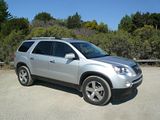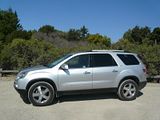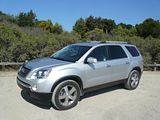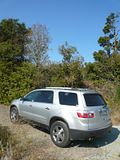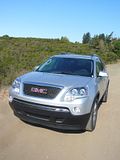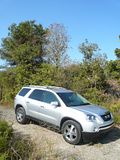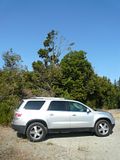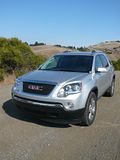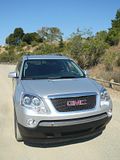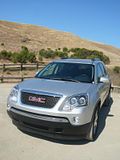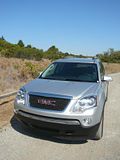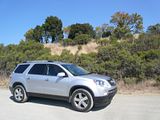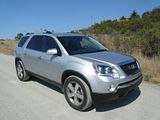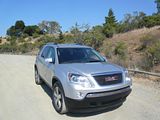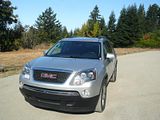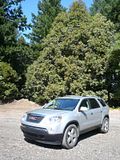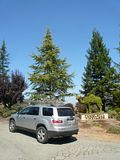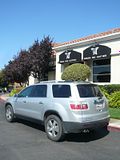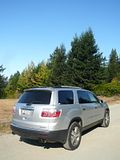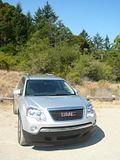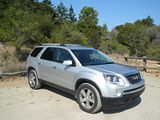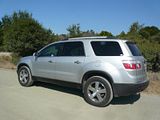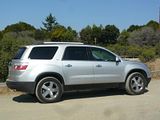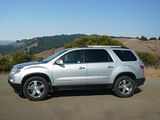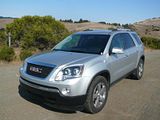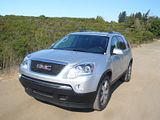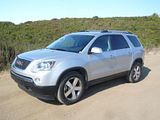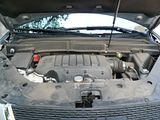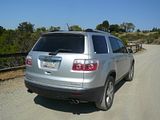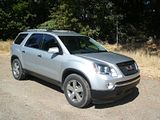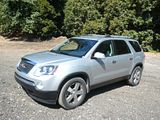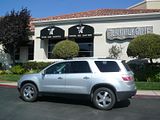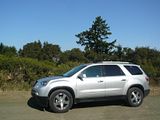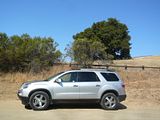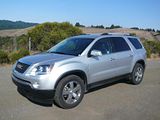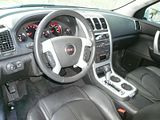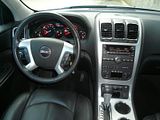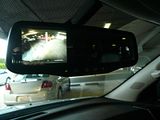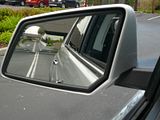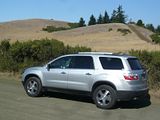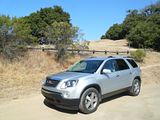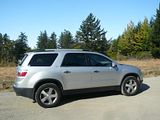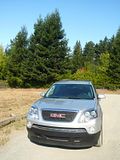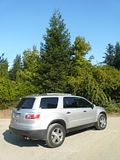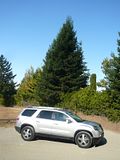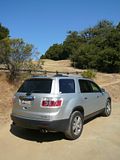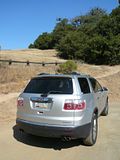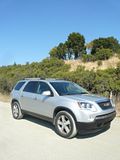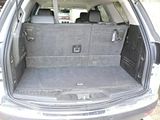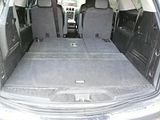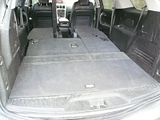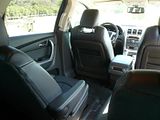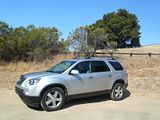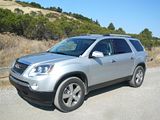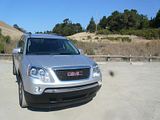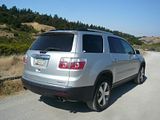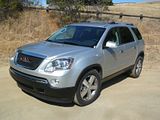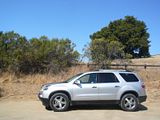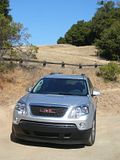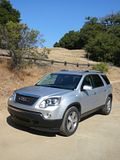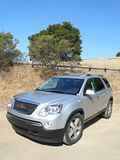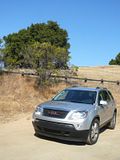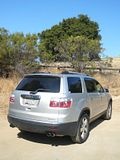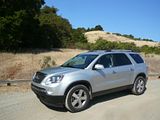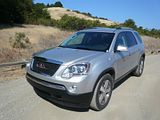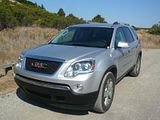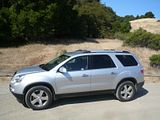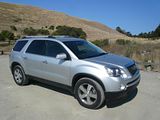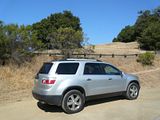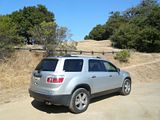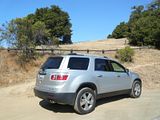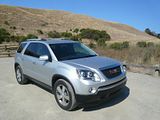When you hear GMC, hands up who thinks that they make trucks? Of course that is their heritage, but when GM spring cleaned the number of brands they had in the Noughties, as one of the surviving four, GMC came to more prominence, with an expanded range of vehicles which whilst not exactly like a regular four door saloon are more “car like”. There are currently three different model types in the range: the large Yukon is visually very similar to the Chevrolet Tahoe and Suburban, and the associated trucks offered by both brands, whereas the smaller and rather boxy Terrain has completely different styling from the Chevrolet Equinox which it resembles underneath. The mid-sized model is called Acadia, and is based on GM’s much praised Lambda platform, which is a 7/8 seater Crossover which replaced both the old MiniVans (Chevrolet Uplander, Pontiac SV6 Montana and the like) and the old SUVs of Chevrolet Trailblazer and GMC Envoy, and is one of what initially were 4 different models badged Buick, Chevrolet, Saturn and GMC. The Saturn went away when GM killed off the brand, leaving just three, so you could now think of the GMC Acadia as the middle version, designed to be that bit cheaper than the Buick Enclave, but a cut above the Chevrolet Traverse. The most obvious differences between the models are the front end styling and the trim levels. I’ve already sampled the Traverse and the Saturn Outlook, so when I acquired an Acadia for a couple of days, I was pretty sure I knew what I was going to experience.
Like all the Lambda models in the GM stable, the Acadia is powered by a 3.6 litre V6 unit, putting out 288bhp, which is 7 bhp more than you find in all bar the top spec Traverse and which also only featured in the top Saturn version. There is a standard 6 speed automatic gearbox. Although front wheel drive models are available, the test vehicle was badged AWD. There are no clues inside the Acadia to tell you that you have an all wheel drive model, and it is not something you can choose to engage or not, so unless you drove the two side by side, I submit you would probably struggle to tell the difference. Although this is a large and heavy machine, the engine does a god job at shifting the GMC, and the Acadia is pleasantly agile. It is not brutally fast, of course, but it is well able to hold its own and the ebbs and flows of the San Francisco traffic, and it also coped admirably with the hills up in the mountains of the area, though of course I was only testing it one up, and not with the weight of a full load of passengers and luggage. At lowish revs, the engine is decently quiet and refined, but it does get a bit more vocal as you work it harder, but it is nothing you cannot live with. The transmission operates very smoothly, changing up and down the gears almost imperceptibly. There is no manual over-ride capability. Given the size and weight of the Acadia, you would not expect particularly impressive fuel economy, so when I crunched the numbers and computed fuel consumption at 20.9 mpg US, or 24.98 mpg Imperial, I was almost agreeably surprised. These are similar numbers to those I achieved with both the Traverse and the Outlook and better than the official numbers, which probably reflects the fact that were far fewer miles done at freeway speed and more at gentler velocities. The other driving dynamics are largely as you would expect.
The steering is pleasant enough, with decent weighting and feel, but it is not something that will encourage the boy racer characteristics of the driver. The handling is fine for a vehicle of this type, with some body roll, but no need to go really slowly on the curved roads joining freeways together as you would have had to in the old Trailblazer, and it was OK on the swooping Skyline Drive, though not exactly fun to drive. It does ride quite well, thanks no doubt to a long wheelbase, and all that weight. The brakes felt a little spongey initially but then responded well to a slightly harder depression of the pedal. There is a foot operated parking brake, which is mounted quite high, so you have to lift your foot a long way up to press and set it. It is released by pressing it harder. Two features on the Acadia contributed to the all-round visibility and manoeuverability of this large vehicle. There are blind spot assistants on both door mirrors. In this case they are small circles on the glass, which give a different field of the view from the main mirror, and there is also the same system as I found in the Camaro, with the rear view camera projecting onto the left side of the mirror on the screen, which was particularly helpful in showing objects low down that you would otherwise not be able to see, even though judging the back of the Acadia is quite easy, even if a long way behind you. With relatively slim pillars and lots of glass, seeing out of it was otherwise good, although the seat belt for the middle person of the back row of seats, mounted from the roof, was something of a nuisance.
The interior of the Acadia is very similar to that fitted in the other Lambda based vehicles, with only detailed differences from the Chevrolet Traverse, the most notable of which is the large GMC logo on the steering wheel boss, though when you do a detailed comparison, you note that there is more to it than that, even though the major components are all clearly the same. It is a huge improvement on the sort of fit and finish that you used to find in GM vehicles one generation back, with plenty of decent quality plastics, mostly quite soft to the touch, and most quite well fitted together. In front of the driver, under a single cowl, there are five dials, alternating between small and large, with rev counter and speedo being the big ones, and water temperature, fuel level and an ammeter being the smaller ones. The outer markings are in red, with white calibrations, and although these were all quite small, they were easy to read at a glance. There is only one column stalk, on the left of the wheel, which operates the indicators and wipers, the latter by twisting the end of the stalk. Lights are controlled by a rotary dial on the dash to the left of the wheel. The centre of the dash is topped by an oddments tray, and then a little lower down is the audio unit which I was pleased to find included Satellite radio. The graphics on the unit looked a little “old school” and it was fiddlier than some to select a station. It also seemed to have quite weak reception so there were plenty of places where it cut in and out even though there was no obvious reason like a tunnel for it to do so. Sitting below this are a series of buttons for the dual zone climate control system. Everything is quite neat and easy to use.
There are no problems stepping up into the Acadia, even without the running boards that featured on a couple of similarly sized machines that I recently sampled. Once installed on the leather clad driver’s seat, there are electric motors to adjust the seat in all directions, so, along with a manually adjustable steering column, it was easy to get the right driving position, and despite the fact that the seat was quite large and appeared a bit shapeless, it proved comfortable. I really did feel that this is the sort of vehicle that you could drive across a State (stopping only for comfort breaks and refuelling) without unduly wrecked at the other end of the destination.
This is a large vehicle, and that is very evident when you look inside it. There are three rows of seats. The middle row comprises two separate chairs with space between them, and then a bench seat is fitted across the back. Passengers in that middle second row are well provided for, as the very nice seats have their own swivel down armrest, and there is an acre of space for them in all directions. They also have their own set of controls for the climate control and auxiliary jacks to plug into the audio equipment of choice. It is not quite so rosy for those who occupy the rearmost row. Getting in is not that hard, and indeed you can easily squeeze between the middle row seats to get there. Once installed, rear legroom will vary depending on the position of the middle row of seats, as will knee room. Headroom is not lacking. Although three children will git quite comfortably across the width of the Acadia, three adults might fit it a bit tight. With all the seats erect, there is some boot space. Room enough for my suitcase and laptop back, for sure, and the luggage area is quite deep, so you could pile stuff up. The rearmost seats are split 50/50 and the backrest simply drops down to create a flat area. The same is true for the Captain’s Chairs in the middle row, and provided you have positioned the base of these well back, you now get a vast and very long and flat luggage area indeed. That seat belt for the middle occupant of the back row of seats is mounted from the roof, and I could not see any way of uncoupling it, so it did get in the way a bit. Inside the cabin, there is a massive glovebox, there are bins on the doors, and there is a cubby on the top of the dash, as well as one under the central armrest, and there is a small area in front of the gear lever. Twin cupholders are situated in the centre console.
The test car was in SLT spec, which is the third of four versions, sitting above the SL and SLE and below the rather pricey Denali. It had quite a lot of nice features on it. SL models are the only ones which come as an 8 seater, as all the others have the Captain’s Chairs in the middle row. SL models cover all the expected bases, with dual zone climate control, an AM/FM audio unit with CD, MP3 and satellite radio, cruise control, lumbar support on the driver’s seat, rear privacy glass, roof rails and 18″ alloys. SLE models add the rear obstacle detection system (which had been damaged on my test car with one sensor slightly pressed into the bumper, meaning that there was a permanent message on the dash telling me it needed to be serviced, even though the system itself was turned off), an 8 way powered driver’s seat and 2 way powered passenger seat, a wireless cellphone link, the rearview camera and the power tailgate. SLT models are offered in 2 sub-variants, with SLT1 adding tri-zone automated climate control, with rear controls, leather seats, heated for those in the front, a Bose audio unit, rear audio controls and a USB port. The SLT2, as my test car, adds a driver’s seat memory and 4-way power adjustment for the passenger seat. The top spec Denali has unique exterior and interior trim, xenons, a wood/leather steering wheel, power sunroof, and a head up display. An AWD SLT2 like the test vehicle lists at $41,965. The top spec Denali comes in at $46,810, whilst the entry point for Acadia with a FWD SL is just $32,835.
There were no real surprises with the Acadia, as it really was very like the Outlook and Traverse, and my conclusions about both of those vehicles were generally positive. If you are in the market for a 7/8 seater Crossover, this remains a very good option, though I have not yet got the experience of its main rivals, the Dodge Durango and Ford Explorer to be able say whether it beats them or not. As to which Lambda based model to pick, that comes down to personal choice. I prefer the front end of the Acadia to that of the Traverse, and of course the Saturn Outlook is long gone. However, in a slightly strange move, the 2013 facelift to the Acadia sees the Outlook body being used, albeit with a rather more dominant grilled design redolent of the GMC Terrain. The other models undergo changes to the front end as well as raft of other alterations, though nothing that will fundamentally change the view that these are competent if unexciting machines. And for those who need a large vehicle as a rental because they have a lot of people or a lot of stuff to haul, they are a decent bet indeed.


